Learn How to Airbrush Aquatic Animals for the Beginner-Learn to Draw Series (Humpback Whale)
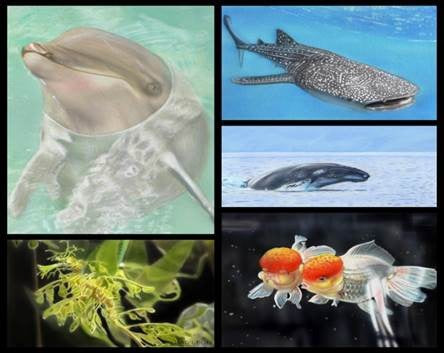
Thanks for purchasing this eBook, as you show a genuine interest in the world of Airbrushing “Aquatic
Animals”. Back when I was learning to draw aquatic animals, I liked watching the wonderful scene
inside the aquarium, of my pet “Goldfish”. At first I was amazed at the features and colors, but when I
kept seeing more details as it moved, an idea struck inside my head. I thought about adding some colors
to my drawing. I kept the drawing for a while, since I’m still learning to paint in acrylic, and after a few
months of browsing some of my files, I saw my drawing again. I decided to paint it in colors with
acrylic using an airbrush, since by that time I already knew how to use an airbrush. I painted it with a
very satisfied result, and later on I saw it hung on the wall of my best friend house. I was so glad!
I’m not encouraging you to give away your masterpiece, rather the point I’m making is that with your
airbrush, you can make limitless fantastic art. If only you could imagine this tool’s greatness with its
capabilities. So, I made this eBook for you to learn the basics of airbrushing that every beginner needs
to know and practice to master it. I made this book also, for an airbrush artist who wants to learn to
paint aquatic creatures. We will be using some other materials to complete our artwork like; Watercolor
pencils, masking film or other masking materials that are available, and many more. First, you have to
invest a little by getting a good airbrush and a reliable air compressor for you to start painting. I also
included all the materials needed for our work, and I’m sure they are available at any art store.
Make some time to read and practice all the exercises in this eBook, and in no time you will be a great
airbrush artist in painting Aquatic Animals. Remember to have fun when spraying with your airbrush!
Animals”. Back when I was learning to draw aquatic animals, I liked watching the wonderful scene
inside the aquarium, of my pet “Goldfish”. At first I was amazed at the features and colors, but when I
kept seeing more details as it moved, an idea struck inside my head. I thought about adding some colors
to my drawing. I kept the drawing for a while, since I’m still learning to paint in acrylic, and after a few
months of browsing some of my files, I saw my drawing again. I decided to paint it in colors with
acrylic using an airbrush, since by that time I already knew how to use an airbrush. I painted it with a
very satisfied result, and later on I saw it hung on the wall of my best friend house. I was so glad!
I’m not encouraging you to give away your masterpiece, rather the point I’m making is that with your
airbrush, you can make limitless fantastic art. If only you could imagine this tool’s greatness with its
capabilities. So, I made this eBook for you to learn the basics of airbrushing that every beginner needs
to know and practice to master it. I made this book also, for an airbrush artist who wants to learn to
paint aquatic creatures. We will be using some other materials to complete our artwork like; Watercolor
pencils, masking film or other masking materials that are available, and many more. First, you have to
invest a little by getting a good airbrush and a reliable air compressor for you to start painting. I also
included all the materials needed for our work, and I’m sure they are available at any art store.
Make some time to read and practice all the exercises in this eBook, and in no time you will be a great
airbrush artist in painting Aquatic Animals. Remember to have fun when spraying with your airbrush!
Airbrush Exercises:
Humpback Whale
Humpback Whale
Now let’s start airbrushing for real. We have a nice subject, including the background, the water, and
the splash effect on the back of the whale.
the splash effect on the back of the whale.
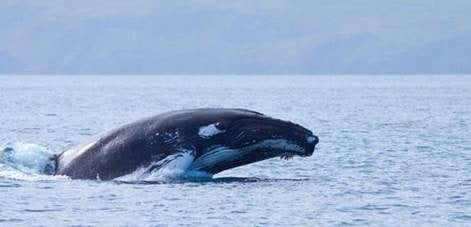
Scan the image below, and print a copy using your printer. You may enlarge it to around 130-150%, as
the larger is your work is, the better you can add details to it to make it realistic. Transfer or trace the
image below to your working paper. You may use a projector, tracing table or the method I mentioned
earlier. Be sure to include important details for the moving water or that small water wave, as it’s
random. Just trace the more evident with small horizontal lines strokes.
the larger is your work is, the better you can add details to it to make it realistic. Transfer or trace the
image below to your working paper. You may use a projector, tracing table or the method I mentioned
earlier. Be sure to include important details for the moving water or that small water wave, as it’s
random. Just trace the more evident with small horizontal lines strokes.
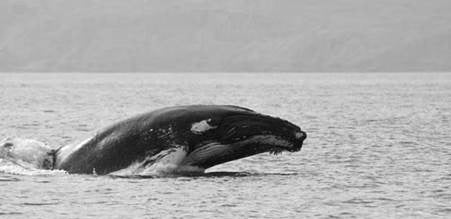
TIP: Careful planning must be considered before starting airbrushing such as; how to create the skin or
texture of the subject.
-There are times I will mention White color, and I usually mean Opaque Titanium White acrylic paint.
Whether you dilute it with water or apply it thickly, it is Opaque White acrylic that I use. Unlike other
colors it is usually transparent paint, unless I mention that you have to use an Opaque paint of that
color.
Steps:
1. After you trace the image, take your kneaded eraser and erase the dark lines that you just drew,
slightly (make sure that you don’t erase too much).
texture of the subject.
-There are times I will mention White color, and I usually mean Opaque Titanium White acrylic paint.
Whether you dilute it with water or apply it thickly, it is Opaque White acrylic that I use. Unlike other
colors it is usually transparent paint, unless I mention that you have to use an Opaque paint of that
color.
Steps:
1. After you trace the image, take your kneaded eraser and erase the dark lines that you just drew,
slightly (make sure that you don’t erase too much).
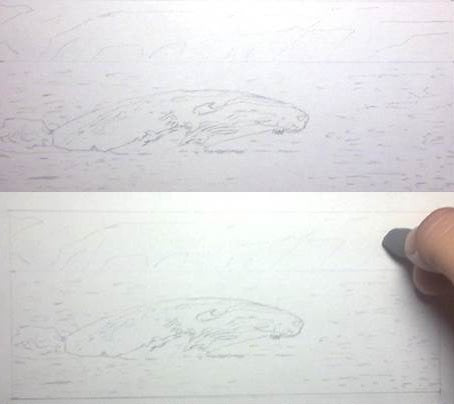
2. Apply Frisket or masking film over the paper.

3. Cut the mask of the Green areas of the mountain; leave the other areas with mask.
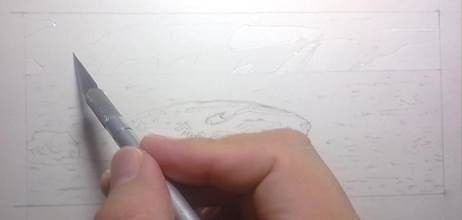
- Spray Ultramarine Blue + Opaque White (to lighten a little) = on the mountain.

Remove the mask and next spray another color, Light Green= , to the green areas (Green with a few
drops; 2-3 drops of white color) on the mountain.
drops; 2-3 drops of white color) on the mountain.

4. Using your Watercolor Pencil in white, lighten some areas of the mountain.

5. Now let’s move to our subject, and mask the top area again. Use paper and masking tape for this,
and cut and remove the mask of the whale.
and cut and remove the mask of the whale.
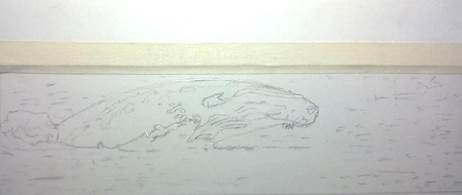
6. Apply Masking Fluid using a ruling pen to the white areas of the whale: areas of the eye, mouth,
flipper, dots on the back.
flipper, dots on the back.
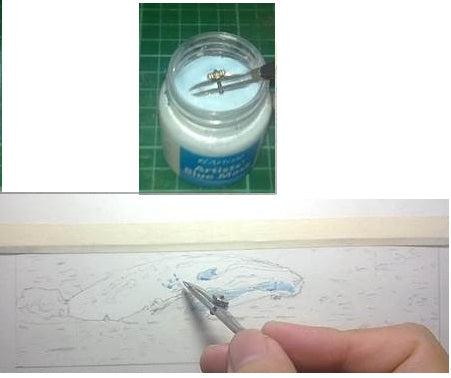
7. Mix the color for the whale body using Blue-Green= (Blue 50% + Green 50%). Spray the body
of the whale and take notes of the light and dark areas of the body, as well as, the transition or
gradation.
of the whale and take notes of the light and dark areas of the body, as well as, the transition or
gradation.
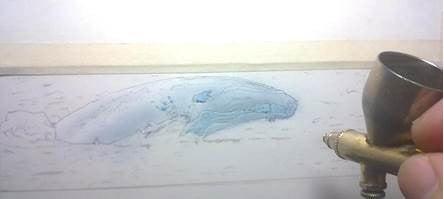
8. Erase some overspray using your pencil eraser.
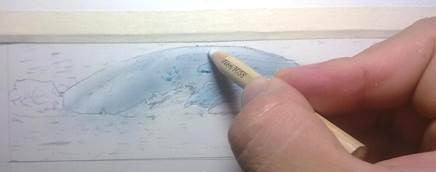
9. Apply the next color for the body which is Dark Blue= (Blue 95%+ Black 5%)
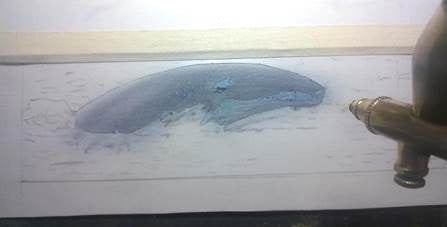
10. Remove the mask and define the white areas of the patch, and dot near the eye with the X-acto
Blade.
Blade.
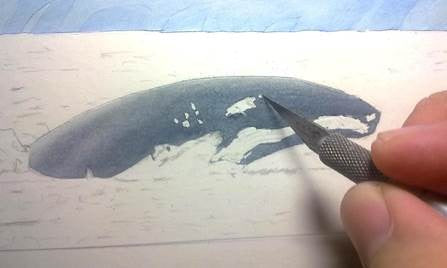
11. Now add details on the features of the whale with Dark Blue and Black Watercolor pencil.
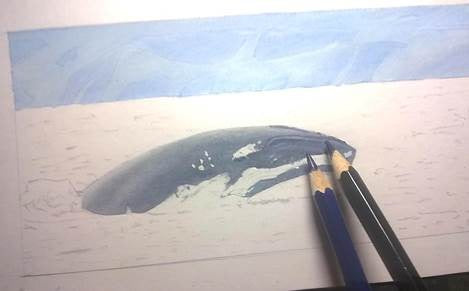
-Blue variants for the lower part of the whale including the splash on the side of the flipper and at the
back.
back.

-For the water just draw some small horizontal lines to create the water effect.
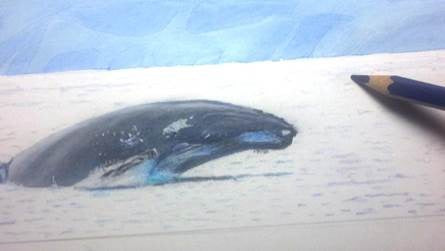
12. Add highlights for the splash with Opaque white Acrylic (just add drops of water to soften for the
soft effect). Note: I just used a Chinese brush, you may use any brush or a Sable Brush for this.
soft effect). Note: I just used a Chinese brush, you may use any brush or a Sable Brush for this.
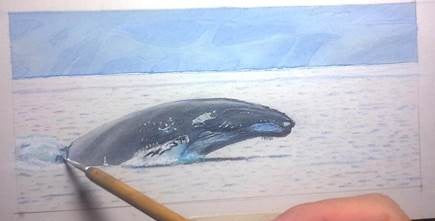
13. Spray Light Sky Blue= (Blue 20% + White 80%) to the back of the mountain and mist some to
the areas on the water on the top of the whale.
the areas on the water on the top of the whale.
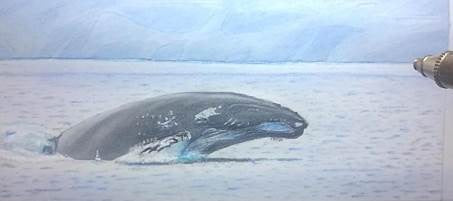
14. Check your work for any corrections, like if you need to darken some areas or lighten: spray or use
Watercolor pencil for details.
Watercolor pencil for details.
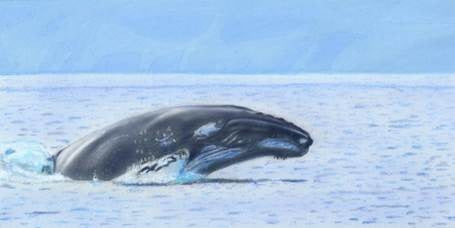
Take a break and after that prepare for the next exercise.
Download this complete book for only $0.99.
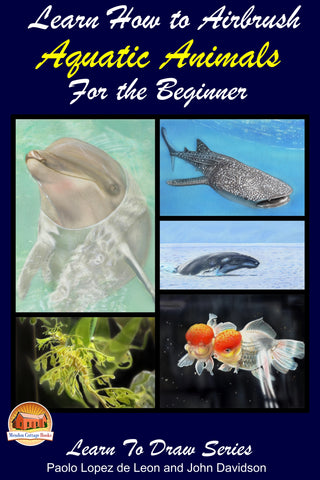
This is a really informative knowledge, Thanks for posting this informative Information. Airbrush Tutorials
ReplyDelete